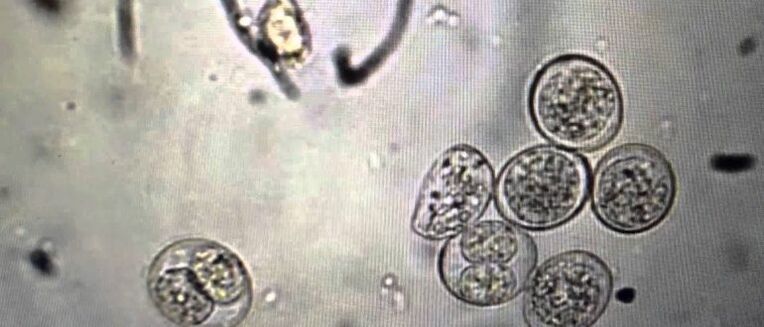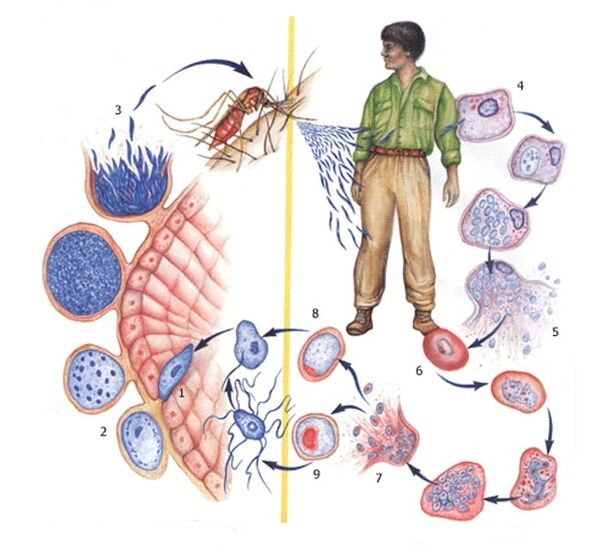
The simplest organisms that live in the water bodies, soil and air of the Earth number up to 15, 000 species. Some of them are the oldest inhabitants of our planet. Over the millions of years that have passed since the appearance of the first living organism, most protozoa have hardly changed. But they have learned to adapt well to new living conditions and find ways to survive. One of the most obvious ways of existence of these organisms has become parasitism, including the human body.
Parasitism
This is a kind of complex relationship between two creatures, when one parasite uses another organism as a habitat or food source.
The organism in which the parasite lives is called the host. It can be permanent when the parasite in it goes through the entire cycle of its development and medium, when the pathogenic organism spends only a certain phase of its life cycle in it.
Parasitism among protozoa is a type of interaction that includes not only life and parasitism to the detriment of others, but also a danger to the life of the host, since many types of parasites cause severe forms of disease in humans, livestock and agricultural crops.
The simplest human parasites have selected almost all organs and systems of the human body, they develop quite actively and sometimes live in it for years. This symbiosis leads to chronic disease and reduced effectiveness of the treatment process.
Ways of entering the body:
- through hands and mouth;
- through the skin;
- contact;
- mother-to-fetal transmission;
- with insect stings, animals;
A comprehensive science that studies the phenomenon of parasitism, the biology of parasites and the area of their distribution, diagnostics, methods of treatment and prevention of parasitic diseases.
The simplest pathogenic parasites that cause various forms of the disease are found almost everywhere. These are fresh and salt water, earth, various household and household items, public places. Protozoal infections are called protozoal or protozoal infections.
What are the simplest human parasites
The human body, like the body of any more or less large animal, is a very attractive object for parasitic life patterns. In addition to protozoa, multicellular parasites (helminths) can live in the human body.
According to habitat, the simplest species can be endogenous (living in the human body) or exogenous (by choosing skin as the habitat). Sometimes parasites, as they develop, move through the body, choosing the habitat that is most suitable for a particular stage of development.
Microscopic sizes and the presence of a primitive structure allow the simplest parasites to successfully survive and reproduce in the most difficult conditions. All representatives of this species are characterized by a structure consisting of a single cell filled with cytoplasm with intracellular fluid, in which all metabolic processes take place with the participation of organelles (structures that perform various functions to maintain vital activity)
The functions of movement can be performed by flagella, cilia and pseudopodia intended for that purpose. The main process (food) is carried out in several ways:
- mouth swallowing cells;
- run around with pseudopods;
- absorption on membrane surfaces.
Adverse conditions can become a signal for the formation of cysts resistant to the external environment of the membranes. They are necessary for the transmission of the simplest human parasites from one host to another and can keep a prisoner inside the parasite for up to several years.
The reproductive cyst is characterized by the formation of a thin temporary shell, which is necessary for protozoa for a short period of division.
Bitan!The simplest human parasites are the causes of protozoal infections: giardiasis, trichomoniasis, sleeping sickness, amoebic dysentery, malaria.
Types of protozoan parasites
According to the way they reproduce and move, the nature of the diet, there are 4 main classes of the simplest human parasites:
Flagellate
For example, lamblia, leishmaniasis, trichomonads, trypanosomes. They have an elongated oval or pear-shaped body. They can have from 1 to 8 flagella of thin cytoplasmic growths, which consist of the finest fibers. They move forward with the flagellum, as if crawling into the space in front of them. They feed by absorbing ready-made nutrients and absorbing them through the membrane. Reproduction in most cases occurs by simple division into two daughter cells. Flagellates can live in colonies of up to 10, 000 individuals.
Sporozoans
For example, malarial plasmodia, Toxoplasma from Gondia. Representatives of this type of protozoa are characterized by a very complex path of development: from the carrier to the human blood, then to the liver, where the parasite multiplies and affects the red blood cells. Reproductive toxins cause disease in the human host. For the next developmental cycle, pathogens must re-enter the host body, where male and female cells mature and spores form. After maturation, the spores are destroyed and the parasite re-enters the host body. The cycle repeats.
Ciliates
For example, balantidia. Cilia are characterized by movement with the help of cilia. There are two nuclei in the cell of the body: the large nucleus controls all vital processes, the small ones are assigned the main role in the sexual side of the existence of protozoa. Reproduction occurs by dividing a cell in half, for most representatives of the species it occurs daily, for some several times a day. The food is moved by the cilia into a special cavity (the mouth of the cell), inside the cell it is processed by the digestive vacuole, and the undigested remains are removed outside.
Sarcode
For example, an amoeba is dysentery. It does not have a permanent shape, it forms many pseudopods, with the help of which it moves and catches food. Multiply by simple division. It can exist in several forms: tissue, luminal, precision. The shape of the tissue lives only in the intestines of the sick person. The rest of the shape can also be found in the body of the host.
Bitan!Primitive structure, cyst formation, the simplest method of reproduction, microscopic size, all these factors allow the simplest parasites to penetrate the most protected tissues of the human body and, in the absence of harmful effects, become the source of a number of serious and sometimes difficult to diagnose pathological conditions.
What diseases are caused by protozoan parasites

The parasitic lifestyle of the simplest microorganisms, in addition to the above factors, also facilitates their ability to anaerobic respiration, although many can use dissolved oxygen.
Diseases caused by protozoan parasites include:
Malaria
The main symptoms are fever attacks, joint pain, vomiting, anemia, convulsions. Enlargement of the spleen may occur. Malaria is characterized by a recurrent course of the disease, with periods of rest and exacerbation. Depending on the type of pathogen, there are different forms: three-day, four-day and tropical. The disease is common in Africa and South Asia. For many centuries, as today, the main remedy for healing was quinine, a medicine made from the bark of the cinchona tree. Despite the creation of synthetic analogues, death from infection occurs in areas without access to modern medical care.
Amoebiasis (dysenteric amoebiasis)
It is caused by the simplest amoeba parasite from the dysentery class of sar codes. The infection can be intestinal and extraintestinal (development in the liver). 7-10 days after infection, the first symptoms appear: abdominal pain, weakness, low temperature (up to + 37, 5 ° C). About 10% may develop severe diarrhea with traces of blood and mucus. Every third infected person gets a fever. It is characterized by an enlarged liver and, in some cases, a liver abscess. If treatment is not started on time, prolonged diarrhea causes dehydration, weakness, and exhaustion of the patient’s body. Outbreaks appear to be exacerbated in countries with warm climates.
Giardiasis
The disease is caused by the simplest class of flagellate lamblia. These parasites have 4 pairs of flagella and a suction disk by which they attach to the inside of the small intestine. Symptoms include infection: upper abdominal pain and bloating, rumbling and nausea, abnormal bowel function, skin lesions (atopic dermatitis), gallbladder abnormalities, general weakness and loss of strength, poor appetite and sleep. Giardiasis is widespread in regions with warm climates in Asia, Africa and Latin America.
Leishmaniasis
The disease is caused by the leishmania parasite from the flagellate class. The main symptoms of cutaneous and mucocutaneous leishmaniasis are skin lesions in the form of ulcers. In the mucocutaneous form, edema and deformity may occur. If the respiratory tract is affected, it can be fatal in rare cases. The visceral form is characterized by enlarged liver and spleen, fever, and anemia. The disease is common in 88 countries, mainly with tropical and subtropical climates.
Trichomoniasis
The disease is caused by the parasite Trichomonas from the flagellate class. The genitourinary system is compromised. The main symptoms in women are itching and burning, hyperemia of the external genitalia, the presence of discharge with an unpleasant odor, sometimes there may be discomfort during intercourse and urination. In men, in most cases, the disease is asymptomatic, sometimes there is pain during urination and urination, symptoms of prostatitis may occur.
Balantidiasis
The causative agent is a parasite from the class of ciliate balantidia. The characteristic symptom is abdominal pain, diarrhea and mucous membranes of the tongue. In acute cases of the disease, fever, signs of general intoxication are possible. The infection can also be chronic, with occasional periods of remission and exacerbation. In complicated cases, intestinal perforation and peritonitis are possible.
Toxoplasmosis
The disease is caused by the parasite Toxoplasma gondia, a sporozoate parasite. The characteristic symptoms of the disease are damage to the eyes, nervous system, heart muscles, enlarged lymph nodes, liver and spleen. It mainly takes place in a chronic form. Often the primary infection is very mild, under the guise of common ARVI. After that, immunity appears forever, and further infection is impossible. The greatest danger to the fetus is during pregnancy: if the child survives, then with severe damage to the nervous system and eyes.
Sleeping sickness
The disease is caused by the simplest parasite of the flagellate class, the Gambian or Rhodesian trypanosome. The characteristic signs in the first phase are fever, headache and joint pain. After 7-20 days, the second phase of the disease begins: disturbances in the perception of the surrounding world, disturbances in the coordination of movements, stiffness and disturbances begin. Outbreaks of the disease are localized in certain regions of tropical Africa, the habitat of the main vector of tsetse fly infection;
Chagas' disease
The causative agent is a parasite from the class of flagellate trypanosoma cruzi. The primary symptoms are fever, swollen lymph nodes, headache, and swelling at the site of the bite. In the initial phase, the signs of the disease may be absent, and after 8-12 weeks, secondary symptoms may begin to develop in 30-40%: enlargement of the ventricles of the heart, enlargement of the esophagus, enlargement of the colon. The second stage of the disease can last 10-30 years after infection. The infection was most prevalent in Latin America.
Bitan!Most of the simplest parasites enter the human body if the basic rules of hygiene and personal hygiene are not followed.
Pathways of infection
The penetration of any microorganism into the human body can occur by penetration through the skin or natural openings. For most protozoan parasites found in the environment, methods of human infection are limited to the four most common:
- Contact and household. This route of infection becomes available to the simplest organisms in violation of the rules of sanitary hygiene and personal hygiene. After all, most microorganisms, when passing from the body of one host to the body of another, can form cysts and remain in that state until they enter a favorable environment, in other words, within the person. Infection can occur at any time: when handling, using other people's household items (towel, bedding, dishes), washing hands with dirty water (in the pond);
- Fecal-oral (giardiasis). In this case, the infection occurs when the parasite leaves the intestines with feces or vomit. If the rules of hygiene are not followed, the parasite enters the water, food or hands of the new host and enters the body. Poorly washed vegetables and herbs can also become a source of infection, and for children dirty hands after playing in the sandbox or with pets;
- Through contaminated food (toxoplasmosis). The meat of most animals, especially wild ones, may contain cysts of protozoan parasites, which enter the human body with insufficient heat treatment. Infection is also possible through dairy products that have not passed sanitary control, and raw fish without sufficient heat treatment;
- Transmissible (malaria, sleeping sickness). Infection occurs by transmitting pathogens through the saliva of the carrier when bitten. The disease is transmitted by infected insects directly to a sensitive organism.
In addition to the main methods of infection, the infection can occur in several other ways, which are much rarer:
- Transplacental with the penetration of protozoan parasites from the infected mother through the placenta to the fetus;
- Hemocontact when blood infected with parasites enters the patient's body (during medical procedures, drug injections, during sexual intercourse);
- Sexually transmitted infections occur only through sexual contact.
Prevention
Prevention of infection with protozoan parasites includes, above all, compliance with all sanitary and hygienic rules. Elimination of the possibility of parasite infestation can be achieved by reasonable adherence to a number of recommendations:
- Heat treatment of meat, dairy and fish products is sufficient (in accordance with the thermal regime according to the technology). Special attention is paid to products that have not passed sanitary control;
- Thoroughly rinse fruits, vegetables, berries and herbs, preferably with boiling water. If heat treatment is impossible, especially for feeding children, it is better to remove the skin;
- Regular medical examinations, especially if there is a suspicion of infection with protozoan parasites;
- Adherence to one sexual partner and refusal to use drugs;
- Special measures can be applied to prevent infection from insect bites: the use of drugs, the destruction of mosquitoes, mosquito nets and insect repellents, the removal of transgenic mosquitoes (resistant to malaria), the creation of vaccines.
Bitan!Of great importance in the prevention of any infection, including the simplest human parasites, is the level of resistance of the organism. After all, if a cyst gets into unfavorable conditions, where it lacks nutrition or immune cells constantly attack a foreign body, then the parasite will either die or leave the host body.
There are a number of foods that are natural immunostimulants (garlic, ginger, broccoli, carrots, green tea) that, when consumed in a balanced way, can provide invaluable help to the body in boosting immunity.
In addition, some products have a negative effect on the growth and reproduction of protozoa, especially those that have settled in the digestive tract: rice porridge and pearl barley, dried fruits, baked apples, vegetable oil, stewed vegetables. When treating parasites, it is necessary to limit or completely exclude products that cause fermentation processes: pastries and sugar.
Currently, the pharmaceutical industry offers many expensive antiparasitic drugs. However, their effective use can be achieved only in combination with preventive measures and adherence to a certain diet, the composition of which can be consulted by a qualified expert.
Do not forget about folk remedies, time-tested and many generations. In the case of a combination of all methods and methods under the supervision of a doctor, the parasites will have very little chance.
Conclusion

At the beginning of the 21st century, it can be noticed that humanity has achieved a lot in the development of parasitology. The message of a new discovery of a particular drug is always gladly accepted by people who need help and treatment today.
The simplest human parasites remain a serious problem in many countries, where the level of development of medicine and society as a whole leaves much to be desired. There are many other places on our planet where diseases such as malaria, drowsiness, leishmaniasis and many others are widespread. People are waiting and hoping that everyone will have a chance to live without disease.
Parasitic diseases are relevant in our time, they require social interaction in all spheres of human life, aimed at improving medical care for the population, compliance with the rules and norms of personal and public hygiene, implementation of preventive measures and sanitary-educational work, sanitation of natural foci of pathogens.
Currently, various scientific studies in the field of parasitology are being conducted in many countries around the world:
- development of scientific bases and methods for monitoring infectious and parasitic infections;
- study of biological characteristics and variability of pathogens of major diseases caused by protozoan parasites;
- quality control and environmental safety of meat and fish products;
- conducting basic research to study the development of pathogens of parasitic diseases, their genetic variability, ecology.




























